I am working on an assignment that I have pretty much already completed, but I wanted to add a small touch to it that attempts to fill the area between the two lines with a colormap based on temperature instead of just a simple color. The way the lines are plotted makes them separate entities essentially, so I know that I'll likely need two colormaps that meet each other or overlap to accomplish this but I'm not too sure how to accomplish this. Any assistance is greatly appreciated.
from datetime import datetime
import pandas as pd
import numpy as np
import matplotlib.colors as mcol
import matplotlib.cm as cm
bin = 400
hash = 'fb441e62df2d58994928907a91895ec62c2c42e6cd075c2700843b89'
Temp = pd.read_csv('fb441e62df2d58994928907a91895ec62c2c42e6cd075c2700843b89.csv'.format(bin, hash))
Temp['Date'] = pd.to_datetime(Temp['Date'])
#Only doing this here because the mplleaflet in my personal jupyter notebook is bugged
#will take longer to execute, will take more lines of code for conversions and ultimately is less efficient than simply doing it with pandas.
#print(datetime.strptime(Temp['Date'].to_json(), '%y-%m-%d')) = datetime.strptime(Temp['Date'], format)
Temp['Y'] = Temp['Date'].dt.year
Temp['M'] = Temp['Date'].dt.month
Temp['D'] = Temp['Date'].dt.day
Temp['DV'] = Temp['Data_Value'].div(10)
Temp['E'] = Temp['Element']
Temp = Temp[~((Temp['M']==2) & (Temp['D']==29))]
GrMin = Temp[(Temp['E']=='TMIN') & (Temp['Y']>=2005) & (Temp['Y']<2015)].groupby(['M','D']).agg({'DV':np.min})
FinMin = Temp[(Temp['E']=='TMIN') & (Temp['Y']==2015)].groupby(['M','D']).agg({'DV':np.min})
GrMax = Temp[(Temp['E']=='TMAX') & (Temp['Y']>=2005) & (Temp['Y']<2015)].groupby(['M','D']).agg({'DV':np.max})
FinMax = Temp[(Temp['E']=='TMIN') & (Temp['Y']==2015)].groupby(['M','D']).agg({'DV':np.max})
#x = GrMax
#y = GrMin
#X, Y = np.meshgrid(x,y)
#Z = f(X, Y)
AnomMin = FinMin[FinMin['DV'] < GrMin['DV']]
AnomMax = FinMax[FinMax['DV'] > GrMax['DV']]
#temps = range(-30,40)
plt.figure(figsize=(18, 10), dpi = 80)
red = '#FF0000'
blue = '#0800FF'
cm1 = mcol.LinearSegmentedColormap.from_list('Temperature Map',[blue, red])
cnorm = mcol.Normalize(vmin=min(GrMin['DV']),vmax=max(GrMax['DV']))
cpick = cm.ScalarMappable(norm=cnorm,cmap=cm1)
cpick.set_array([])
plt.title('Historical Temperature Analysis In Ann Arbor Michigan')
plt.xlabel('Month')
plt.ylabel('Temperature in Celsius')
plt.plot(GrMax.values, c = red, linestyle = '-', label = 'Highest Temperatures (2005-2014)')
#plt.scatter(AnomMax, FinMax.iloc[AnomMax], c = red, s=5, label = 'Anomolous High Readings (2015)')
plt.plot(GrMin.values, c = blue, linestyle = '-', label = 'Lowest Temperatures (2005-2014)')
#plt.scatter(AnomMin, FinMin.iloc[AnomMin], c = blue, s=5, label = 'Anomolous Low Readings (2015)')
plt.xticks(np.linspace(0,60 + 60*11, num=12),(r'January',r'February',r'March',r'April',r'May',r'June',r'July',r'August',r'September',r'October',r'November',r'December'))
#Failed Attempt
#plt.contourf(X, Y, Z, 20, cmap = cm1)
#for i in temps
# plt.fill_between(len(GrMin['DV']), GrMin['DV'], i ,cmap = cm1)
#for i in temps
# plt.fill_between(len(GrMin['DV']), i ,GrMax['DV'], cmap = cm1)
#Kind of Close but doesn't exactly create the colormap
plt.gca().fill_between(range(len(GrMin.values)), GrMin['DV'], GrMax['DV'], cmap = cm1)
plt.legend(loc = '0', title='Temperature Guide')
plt.colorbar(cpick, label='Temperature in Celsius')
plt.show()



